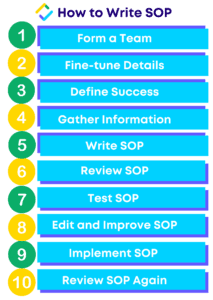What is SOP?
SOP or standard operating procedure is a list of step-by-step instructions that guides team members on how to perform a complex task. SOP can also refer to the documentation of these instructions or the process of writing them. Both help businesses define and develop their processes and improve quality.
This article is a guide on how to write SOP as in the documentation, which includes the actual procedure for performing a task (also known as SOP) and other parts.
Preparing to Write SOP
Though it can be tempting to just jump into writing the SOP, it’s necessary to ask and answer the following questions first:
- Why do you need to write the SOP?
- Who is the SOP for?
- Who can help you write the SOP?
- What is the SOP all about?
- Where will the SOP apply?
- When do you need to implement the SOP?
- What challenges do you expect to experience?
- What are the current blockers or obstacles to writing the SOP?
- What are possible future blockers or obstacles to SOP implementation?
- What else do you need to write the SOP?
Asking and answering the questions above will help make writing SOP much easier as it helps form a clearer understanding of the context in which SOP is needed and written. These questions also feature some logistical or organizational issues that might pop up in the future and for which it is better to be prepared.
What does an SOP include?
An SOP includes the following:
- Title Page
- SOP identification number
- Task SOP is being written for
- Date SOP was created
- Date SOP was finalized
- Date/s SOP was revised
- Names of people involved in writing SOP
- Department or group SOP applies to
- Table of Contents
- Purpose and Scope
- Procedure (actual SOP for the task)
- Success Metrics
- Responsibilities
- Approval Signatures
Create Your Own SOP Checklist
Eliminate manual tasks and streamline your operations.
Get started for FREESOP Format
SOP format is how the list of instructions are presented or structured. Some examples of SOP format are step-by-step SOP format and hierarchical SOP format. There is only a slight difference between these two and to illustrate this, and give you an idea of what standard operating procedures look like, the next section features an SOP example written in the step-by-step SOP format and in the hierarchical SOP format.
SOP Example
Before proceeding, keep in mind that the SOP being referred to here is the actual SOP for the task (procedure part only), and not SOP documentation (procedure part + all other parts).
| Step-by-Step SOP Example |
| Hierarchical SOP Example |
|
Using whichever SOP format depends on the amount of detail needed for each instruction. If the team members for which the SOP is being written for are familiar with the instruction, if they already know how to carry out the instruction, or if the instruction is fairly straightforward, you can choose to go with the simpler step-by-step format. But if the instruction is complex or new to the team, then it would be better to incorporate the hierarchical format.
Note that while using only one SOP format can help in ensuring the uniformity of the SOP, if the team’s familiarity with the instructions or the complexity of the instructions varies, it could be helpful to use both SOP formats in a single SOP.
How to Write Standard Operating Procedures

Step 1: Assemble Your Team
Writing an SOP is not a one-person job. Since SOPs must always be correct, it is highly critical that the people you include in your SOP writing team know the ins and outs of the task the SOP is being written for. It is also critical to include at least one representative from the team or group that will use the SOP or to whom the SOP applies. Ideally, this representative should have firsthand experience of what their team members go through on a daily basis, their struggles, strengths, weaknesses, and habits. For alignment, make sure to train each member on the process of properly writing SOPs.
Step 2: Fine-tune the Details
Ideally, by this time, the core elements of the SOP, such as scope and purpose, have been established and noted. This step requires that you and your SOP writing team further develop these core elements through discussion, investigation, or other means of examination. The goal of this step is to help make the basic details of the SOP clearer so that the writing of the actual procedure later on is quicker and easier.
Step 3: Define Success
Closely related to the purpose of the SOP, success metrics are what you will use to gauge the effectiveness of the SOP during testing, reevaluation, and after implementation. Start by asking the following questions, together with your SOP writing team:
- What does success look like?
- How will we know if we’ve succeeded?
- How much weight will we give to the effect of the SOP on productivity or efficiency?
- How much weight will we give to the intended audience of the SOP actually using the SOP and liking it or finding it helpful?
To answer these questions, it may be necessary to interview the people who will be using the SOP or have a conversation with their managers. Doing so will ensure that your answers are in line with the goals and activities of the team and that the finalized success metrics are aligned with their expectations.
Step 4: Gather Information
Though ideally your SOP writing team should be composed of people employed by the business and who are experts on the task, if this is not the case or if further clarification is needed, you may choose to consult with third-party experts or specialists to help narrow the knowledge gap. Additionally, you may conduct more interviews with the team the SOP is being written for or ask for the input of higher-level executives within the business.
Step 5: Write SOP
Using the information you have gathered in the previous step, you can finally start writing the SOP or the actual list of step-by-step instructions on how to perform the task. While writing the SOP, be sure to include the equipment, materials, and other assets needed for each instruction, helpful tips, warnings, common mistakes, the do’s and don’ts, as well as photos or other references that would help guide those following the SOP.
Step 6: Review SOP Thoroughly
Have each member of your SOP writing team read the SOP. Keep a look out for technical or grammatical errors, inconsistencies, unrealistic aspects, and possible difficulties with implementation. Ask the team or group who will be using the SOP for their thoughts and points for improvement. Share this first draft of the SOP with the team’s managers and incorporate their suggestions.
Step 7: See the SOP in Action
Once the initial review of the SOP has been completed, you may then proceed with testing the SOP. To do this, you can ask the team for whom the SOP is intended to use it just for one day or for one shift to see if it works. You can also try experimenting with different conditions and situations to find out if the SOP is adaptable or versatile enough. Remember to record observations and the test results as you will use them in the next step.
Step 8: Reevaluate, Edit, and Improve
After testing the SOP or even while the SOP test is ongoing, you can begin the process of reevaluating the SOP. Remember though that any major edits should take place only after testing. Start the reevaluation by asking the following questions:
- What worked?
- What didn’t?
- What are the weak spots of the SOP?
- What are the strengths of the SOP?
Discuss the answers to these questions with other members of your SOP writing team as well as the team the SOP was written for and their managers. Once all questions have been sufficiently answered, make revisions or edits to the SOP based on these discussions and on the test results.
Step 9: Plan for Implementation
After all improvements have been made, send the SOP to the head manager of the team it was written for (the person above their managers) and other executives. If they have any comments or suggestions that could help further improve the SOP, make edits and resend. If they no longer have any comments or suggestions and have given their approval signatures, you can start planning for the SOP implementation.
As the SOP implementation will depend on the specific SOP written and on the structure of the business, the exact steps regarding SOP implementation will be up to you.
However, there are two things to keep in mind. The first is to ensure that the team the SOP was written for is given an introduction, orientation, or demo on how to use the SOP correctly. The second is to ensure that the SOP is available and can be accessed conveniently by the intended team.
Step 10: Continuously Review SOP
Though an SOP should ideally be the best way to perform a task, this doesn’t mean that it should just be followed blindly or not criticized. To truly stand the test of time, it must be a dynamic document that is constantly updated and improved. Once the writing of the SOP has been completed, set a reminder or a schedule for reviewing the SOP.
Make sure that you choose a specific date and refrain from merely stating that you will review the SOP regularly, as it can be easy to forget to do so.
Achieve operational excellence
Cultivate a culture of excellence with our digital solutions that enhance efficiency, agility, and continuous improvement across all operations.
Explore nowUse SOP Template for Writing SOP
Writing SOP using a paper-based process involves needless manual duplication. It can be exhausting to have to copy the same details again and again as you go through each step of SOP writing. On the other hand, with a digital solution, all of the details you’ve discovered previously are instantly saved in a single, secure location. Digital SOP templates are also easier to customize, share, and update than paper forms.
Start writing SOP without the hassle and difficulties of inefficient pen-and-paper methods. Use any of our ready-built digital SOP templates for free.



